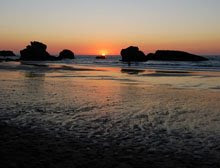 Proposal for community allotments on a back street in Waterloo.
Proposal for community allotments on a back street in Waterloo.

 Proposal for community allotments on a back street in Waterloo.
Proposal for community allotments on a back street in Waterloo.






Compost and Waste Management
I have been to Kew several times – but this time I was given the chance to see a bit of the behind the scene of the running and management. As part of our theoretical module on the course we met David Barnes, the Manager of Horticultural Support at Kew.
Kew Garden has a responsibility to protect and take care of its collections of plants and seeds. With this comes a responsibility to its surroundings and setting as well. Kew is located on flat, dry and free draining gravely and sandy soil. The soil gets very dry in the summer – with nutrients draining away. Kew is also located on the Heathrow fly path and the emissions and pollution also affects the garden and its species.
Irrigation is a must for Kew. The irrigation system has recently been updated. The water comes from the mains and fills up a 70 000 litre storage tank – from there it leads to water ring circulating the whole site and from there feeding directly to the plants. This reduces the leaks and makes it easier to control which areas you water.
Rainwater is collected from the main buildings and fills up tanks. The rainwater collecting system is not as developed as they would like – but is something they are looking on improving for the future.
The composting system is well developed at Kew. All the plant material from the maintenance on site is broken down to compost on site. It is all a natural and organic process with only stable manoeuvre added to the other ingredients of water and CO2. The manoeuvre comes from the stables at St John’s Wood.

The compost yard has been there for 10 years and is built on concrete with a moat surrounding and collecting the runoff water from the compost heaps. This is to protect the Thames from runoff water which has very high levels of nutrients. The runoff water is instead collected and lead into a tank where it is filtered and then used to water the compost heaps.
The materials are sorted on the yard by heaps of: herbaceous, manoeuvre and woody materials. The woody materials are shredded and screened. Whilst the herbaceous materials only need shredding. The wood chips are mixed 4:1 with the manoeuvre. Water is added and the heap is turned once to further speed up the process. It takes about 8 weeks before it is ready to go back out in the gardens to be used as surface mulch.

Close up look at the wood chips mixed with manoeuvre and to the right the wood chips are completely broken down into surface mulch.
The herbaceous materials are mixed on a 1:1 with manoeuvre. No water is added to this process as the herbaceous materials already have a high level of water. The compost is ready after 6 weeks and is used as soil conditioner which is dug down to mix with the soil on a deeper level.

An interesting fact about the compost heaps are the high levels of energy that they generate. David Barnes mentioned that pipes could be lead underneath the heaps to help with possible water heating for an example. This is something I am surprised that Kew has not investigated further yet.
The talk also reached a point of discussion the waste generated by the public and if this is recycled. At the moment there is no recycling in place for this. David Barnes said that most of the waste from the public is high level of low weight plastics. Which is costly and complicated to recycle and there is issues with storing that amount of waste on site. But he said that he would like to put some systems in place.
I think the clue for this may lay in the management of the visitors. Waste is something that is hard to control – cause even if the food and products sold on site are being controlled and more sustainable – you can’t keep people from bringing in their own food and waste to the site.
The issue of carbon footprint was also discussed and I think that David Barnes answered the questions very well. He said how do measure the carbon footprint for a site for Kew. There is obviously the energy the site uses and the carbon that it emits. There is also certain inherited carbon in the buildings and also all the people visiting Kew.
The later can be put done to trying to manage your visitors and the way you can encourage them to think about the way the travel to the site for an example. Like the Eden Project gives discounts to everyone that arrives by cycle or foot. This could be tried at Kew by maybe give discounts to everyone that produce a travel card or people showing that they live locally and can show that they walked to the site.
The visit was interesting and it was good to see the composting process which is surprisingly simple and organic. I think I site like Kew still has a long way to go in sustainable management processes – but by listening to David Barnes you realise that the interest is there and it comes downs to costs and procedures.
 Went to Kew Gardens on a great autumns day. Never been during the autumn before and it was quite different. Also the opportunity to go up the tree top walkway. It was very cool, but actually when you were there my first impression was that it was quite short. I thought that it would have been a lot longer (even though I realise that it would have been quite impractical, expensive and too disturbing for surrounding trees roots).
Went to Kew Gardens on a great autumns day. Never been during the autumn before and it was quite different. Also the opportunity to go up the tree top walkway. It was very cool, but actually when you were there my first impression was that it was quite short. I thought that it would have been a lot longer (even though I realise that it would have been quite impractical, expensive and too disturbing for surrounding trees roots). As part of the LI conference I went on a site visit to the Crown Estate allotments by Regents Park. In terms of estates it was quite a posh one (if there are posh estates?). The allotments were sunken down in the middle of of a courtyard with apartment blocks on the sides. It was fenced off, but still looked ok on a sunny, bright autumn day. Underneath the allotments is a disused basin and it also has got an underground river running below it.
As part of the LI conference I went on a site visit to the Crown Estate allotments by Regents Park. In terms of estates it was quite a posh one (if there are posh estates?). The allotments were sunken down in the middle of of a courtyard with apartment blocks on the sides. It was fenced off, but still looked ok on a sunny, bright autumn day. Underneath the allotments is a disused basin and it also has got an underground river running below it. 



 Abounded marble quarry, Vermont, Canada (http://www.edwardburtynsky.com/index.html)
Abounded marble quarry, Vermont, Canada (http://www.edwardburtynsky.com/index.html)Went to see Manufactured Landscapes at the BFI. It is the documentary about Edward Burtynsky's work from the last 10 years when he has been photographing the way industrialisation has changed the natural landscapes and the environment.
The photos above is how he started by looking at quarries in his native Canada, photographing how our life and industries are changing the landscape for good. The why he photographs it making it beautiful, until you actually start looking closer and realising what the photo is showing.
Some of the parts in the film is like another world. There are these images of what should be a green landscape and you can't see any plants or texture anywhere... It is incredible.
 The Three Gorges dam (http://www.edwardburtynsky.com/index.htm)
The Three Gorges dam (http://www.edwardburtynsky.com/index.htm)The film shows the making of the Three Gorges dam along the Yangtze river. It is the largest engineering and construction site in the world, which has caused displacement of 1.2 million people and destroyed 11 cities. What is incredible is the the people in the villages are being paid to take down their own houses and the way it is done by hand is unbelievable.
 (http://www.edwardburtynsky.com/index.htm)
(http://www.edwardburtynsky.com/index.htm)



 View of the courtyard at Somerset House
View of the courtyard at Somerset House The proposed new city to sea path
The proposed new city to sea path














